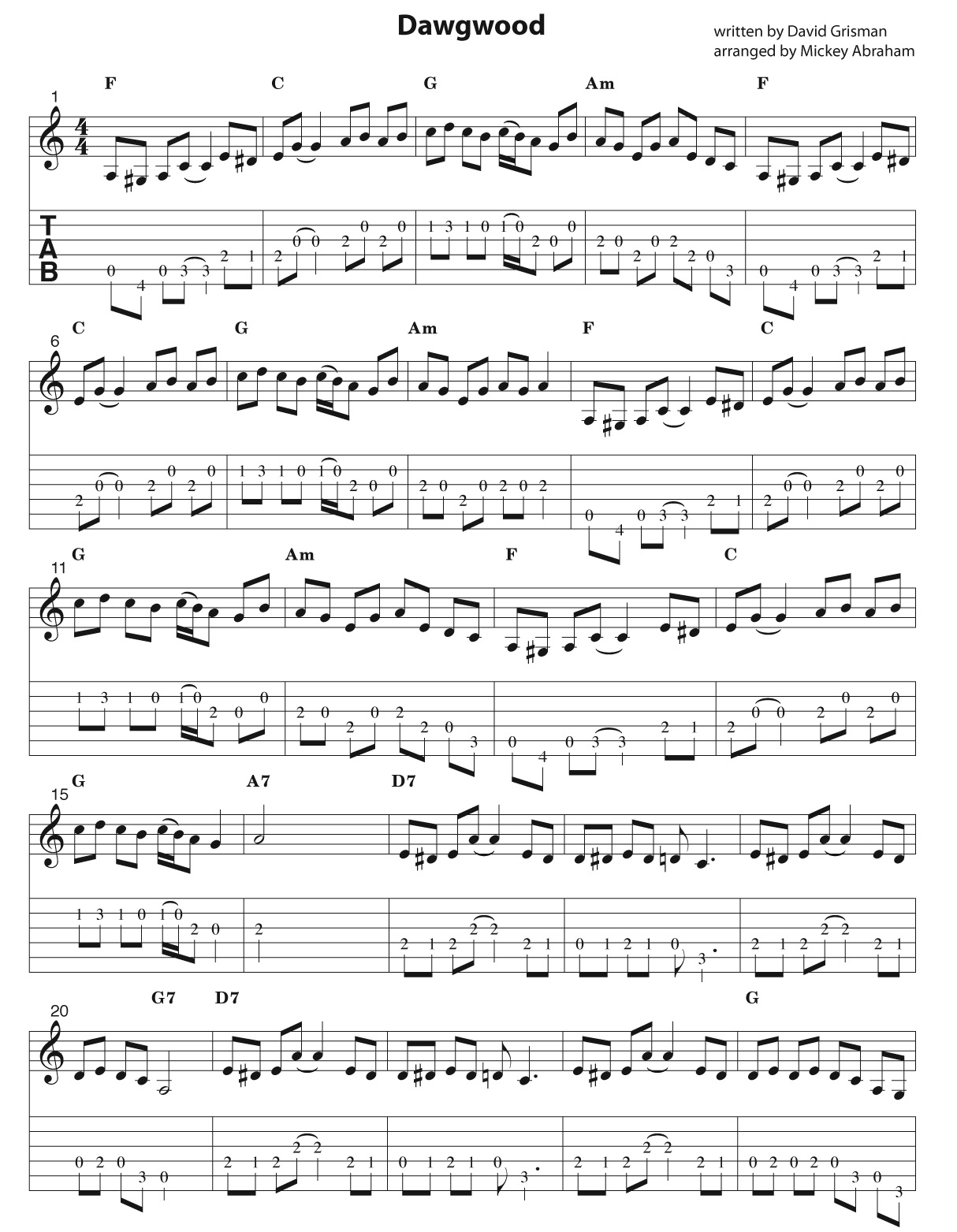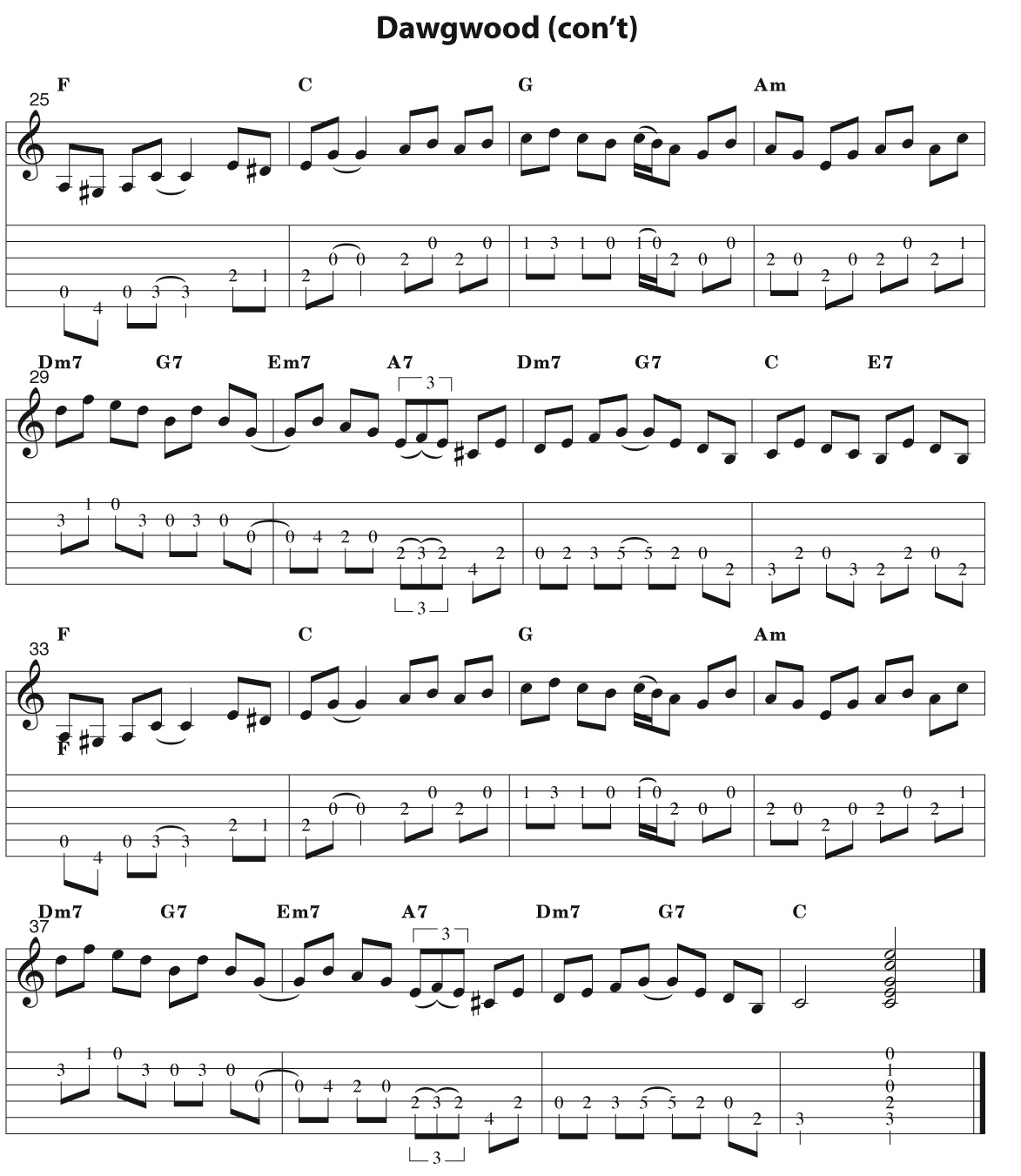|
February 2010 Free Flatpicking Lesson
from
Flatpicking Guitar Magazine
"Dawgwood" by David Grisman
Arranged for FGM by Mickey Abraham
Hello and welcome to FGM’s free flatpicking lesson. This
month I present to you a true classic from the archives of the
“traditional” new-grass world. In the early seventies mandolinist David
Grisman was a pioneer when it came to fusing other styles of music into
bluegrass. His unique fusion of jazz, latin, and swing has come to
known as Dawg music (after his nickname, the Dawg), and many of his
original tunes have, over time, become jam session standards. I’d like
to thank Craig Miller of Acoustic Disc for allowing me and FGM
permission to use “Dawgwood” in my e-lesson. I hope you have as much
fun learning this tune as have had arranging and teaching it!
It is because so many
of Grisman’s tunes have become standards in the bluegrass and mandolin
world that I set forth my goal to spread these now famous melodies
amongst us flatpicking guitarists. The melody to “Dawgwood” actually
makes a fantastic flatpicking tune -- the positions feel similar to
“Billy in the Low Ground” and “Beaumont Rag.” I know that once you work
it out, you will be sharing this addictive tune with your friends.
“Dawgwood” is like a
combination of a fiddle tune and a rag. Their may be a few more chords
than you are used to, but the melody is no more technical than
flatpicking standards you may already know. In fact, once you spend a
little focused time on this piece, you will be amazing on how hip you
can sound with a simple melody! I feel like I have heard versions of
“Dawgwood” with slightly different chords, but David insists that he has
not changed the chords since 1974 when he wrote the song!
The “A” section is basically
the same phrase played four times with a slightly different melodic
ending each time. In the back-up, you will notice that Am is changed to
an A7 right before the bridge. The way I pick the reoccurring triplet
in the melody is by pulling off the first fret of the “b” string to the
open “b” string with one down stroke -- then, striking the “g” string
open with an up stroke. This way, the triplet comes out fluid and the
pick direction stays correct! I love the chord progression on the “A”
section. I’m sure you have played these four chords so many times, but
have you ever put them is this particular order?
The “B” section picks up the
groove with a cool D7 rhythm. I especially enjoy how Grisman leaves
space between the phrases. This really allows the melody to speak like a
conversation. When picking the turnaround look out for the eighth note
rest -- You will have to begin this phrase with an upstroke. The
triplet in the turaround is picked with one down stroke followed by a
hammer and a pull-off. You achieve three notes with one pickstroke.
At the end of the turnaround, unless you are ending the tune, use the
E7 chord to get back to the beginning. At the end, you must leave the
E7 chord off the turnaround (landing on the C) and this will conclude
“Dawgwood”! Listen to my e-lesson mp3 to hear how the E7 works in the
song.
Finally, after you learn the melody, I encourage you to begin jamming
solos over the song. One important staple of Grisman’s music, and all
the great guitar players that have been in his band, has been the
improvisational element to their music. It is within the tradition of
bluegrass and Dawg music to improvise over the changes to a tune. I
asked David to offer my e-lesson readers a few thoughts on improvising
through the changes of “Dawgwood” and here’s what the Dawg himself had
to say:
“Well, there are several approaches towards
improvising or soloing. You can relate to it harmonically (staying
inside or outside the changes), rhythmically, and/or melodically. I
like to use a combination type process. Sometimes you want to
acknowledge so to “speak” the chord changes and, at other times you want
to, more or less, ignore them. Ultimately, I try to play what sounds
good, based on my knowledge of the song and what I’m trying to express
with it, which is at times quite personal since I’ve had the experience
of writing the tune.”
I could not have said it better
myself! As always, please email any questions, comments, or concerns
you may have on this FGM e-lesson or any great ideas for future
e-lessons to [email protected]


|